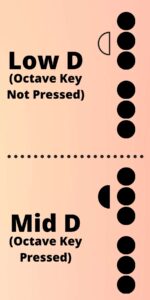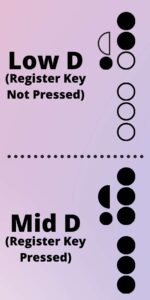Saxophones are among the larger of the woodwind instruments, but that shouldn’t deter people…especially kids…from pursuing it. Some band teachers will encourage younger students to start on clarinet and then switch to saxophone later on. I wanted to dispel that rumor, as a saxophone player myself I have my opinions, but I decided to ask some of my band teacher friends to get there opinion.
In general, large hands are not needed to play the saxophone since the spread of keys fits comfortably in most peoples hands. The average man has a hand size of 7.6 inches while woman average at 6.8 inches. The longest key stretch on a saxophone is to the G-key, which is about a 6 inch stretch.

| Left Hand | Length | Right Hand | Length |
| B-Key | 5 in | F-Key | 4.5 in |
| A-Key | 5.75 in | E-Key | 4.75 in |
| G-Key | 6 in | D-Key | 5 in |
The information above is based on my own saxophone, so your mileage may vary. Remember, the left hand will need to wrap around the high D, E, and F palm keys and the right hand need to get around bottom palm keys.
Do Kids Need Large Hands To Play The Saxophone?
The average fifth grader has hands that are big enough to play an alto saxophone, which is the starting sax for new players. An alto sax measures 5.75 inches from the octave key to the front keys and 4.75 inches from the thumb rest to the lower keys. The hand size for an 11-year-old is 5.5 to 6.8 inches.
Even if your hand doesn’t quite measure up, even veteran sax players who are fully grown will need to shift and move their hands to reach some of the keys…for instance, the right hand will regularly have to pivot up to hit the top palm key.
Why Are Kids Told Their Hands Aren’t Big Enough To Play The Saxophone?
I’ll start by giving the benefit of the doubt to the teacher. They are experts in music education and want what’s best for new players. However, not all of them are saxophone players themselves so they may not fully understand the functionality of the sax.
Yes, it’s a heavy instrument…but there is a large thumb rest for the bottom right hand to balance some of the weight and a thumb pad for the left hand to help balance the tilt of the instrument. Almost all of the weight of the saxophone is held by the neck strap, the hands just help with balance and left/right positioning.
Since the thumbs aren’t holding much of the weight, a player’s hands are free to slide around the instrument a little as needed to reach some of the keys. This movement usually isn’t required for the main six keys on the front of the instrument but may be needed to reach some of the pinky keys (called the spatula keys.)
The good news here is that new students won’t need these very often the first year that they play. The exception here might be the G-sharp key on the left hand…but there’s more good news here, this is the easiest of the left pinky keys to operate and reach in fact, the pinky should already be resting on it. The other spatula keys (both left and right) are used for the lowest notes on the sax which won’t be needed until the second year of playing at the earliest.
Another thing to consider is that maybe the teacher is spot on with their assessment. Some kids don’t get their growth spurts until Jr. or even Sr. high school and if the child is already on the smaller side then they might struggle to properly hold a sax and reach the keys.
Lastly, there might be a little ulterior motive for some music teachers. I don’t think it’s overly malicious, but something to at least consider. Some teachers may be concerned not enough kids are choosing to play the clarinet or other winds. The saxophone is a very popular instrument and many students gravitate toward it. Some teachers may coax some students into other instruments so that they can have a more balanced band.
Again, I don’t want to emphasize that last one too much since the vast majority of teachers do mean well.
How Can Students Or Parents Handle This Situation?
The most important thing is to consider what the music teacher is saying. As a parent, ask yourself if you think your child can handle the weight and size of a saxophone and can cope with any complications and…most importantly…overcome them and stick with it.
If you’re unsure you can always go down to your local music shop and ask if your child can hold an alto sax. They don’t need to actually try to play it, just have them sit with the instrument for a few minutes and see how their hands fit against the keys.
The key here is to not make a child settle for an instrument they don’t have their heart set on playing…they’ll just lose interest. At the same time, if a kid is struggling with an instrument then that will also cause them to lose interest. It can be a fine line to walk.
If everyone is in agreement that the student does need to begin on clarinet then point out the positives. Transitioning to saxophone in a year or two will be easier because they will already know most of the saxophone fingerings. By the time they get to high school, they will already know how to play two instruments which will open up possibilities for them to play in pit orchestras for school musicals and already give them a leg up in jazz band.
What Difficulties Might A Smaller Than Average Child Have If They Decide To Play The Saxophone?
I’ve already mentioned a few of these above, but I wanted to reiterate them here since you want to consider everything you can to help your child succeed at music. Band and orchestra already have a high attrition rate as students proceed through the years, so you want to make their decision to stick with it as easy as possible.
Smaller students might have a hard time holding the weight of the instrument. While most of the weight is held by the neck via a neck strap, that is still roughly 5 pounds (alto sax weight) hanging there for an extended period of time. Only a small portion of the sax’s weight sits on the right thumb, but again, this is still a lot of weight for a child’s thumb to have to support for several minutes at a time.
There have been some studies by dentists and orthodontists that playing the saxophone can cause misalignment of a student’s teeth and that kids that already have braces may have a few extra difficulties when playing. I go into more details over here in this article: Can I Play The Sax If I Wear Braces?
It can take quite a bit of air to play the sax so a child may find themselves short of breath and fatigued if they try to overdo it. Their lungs will get used to the air required to play over time, but a few breathing exercises can help speed things up. Luckily, one aspect of beginning music classes is to learn how to spot breathing points which are usually marked in young bad pieces with an apostrophe.
While Smaller Than The Sax, The Clarinet Introduces Other Challenges
In general, the clarinet is a more difficult instrument to learn. A teacher may be concerned about hand size but they might be overlooking the difference in technical handling that the clarinet requires.
First of all, the saxophone has a smaller range (amount of notes that it can play) than the clarinet. Now, this isn’t a huge deal starting off since everyone is only learning a few notes at a time. But as music students enter their 3rd and 4th years of playing, the number of notes a clarinetist needs to learn the fingerings for becomes vaster than the notes a sax player needs to learn the fingerings for.
There are two reasons for this:
- Range of the Instrument
- How the Register Key Works on Each Instrument.
The Range of the Instrument
The range of a saxophone is from low Bb to high F# and the clarinet can play from low D to the Bb above high C (see range chart to the right.) This means the clarinet can play 8 notes lower (as written) and 4 notes higher (also as written) than the saxophone.
How the Register Keys Work on Each Instrument

Saxophone – The register key (the key that the left thumb operates) on a saxophone is more commonly referred to as the octave key. This is because it will make a low note jump exactly one octave when pressed.
Basically, every note on the saxophone between low D and high C (again, see chart at the right) is fingered the exact same way…except the octave key is pressed as you move up to the next D and onward.
The fact that the saxophone has common fingerings for its lower register and its middle register is one reason to argue that the saxophone is a little easier to learn than the clarinet…not to mention the easier assembly of the instrument itself.
The saxophones body is one, solid piece…only the neck and mouthpiece come apart.

Clarinet – For the clarinet, the register makes the lower fingerings just up a 12th, so a low D has a different fingering than the D above it.
This transition point, called the break, requires memorizing a new set of fingerings….which happen to be the same as the saxophone fingerings, funnily enough.
As far as assembly, in addition to the mouthpiece and neckpiece, the body of the clarinet also comes apart. Players need to take care to line up the two pieces so that the key mechanisms will attach properly.
